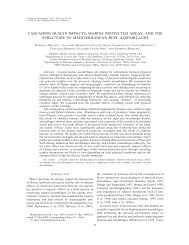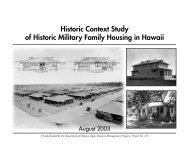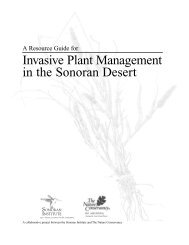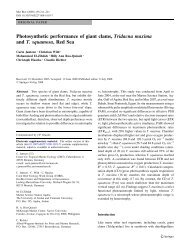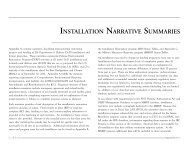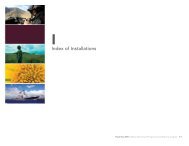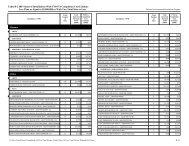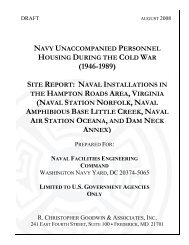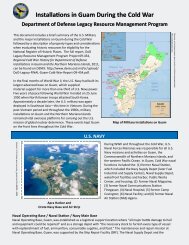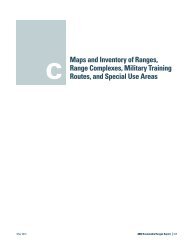Appendix M: Installation Narrative Summaries - denix
Appendix M: Installation Narrative Summaries - denix
Appendix M: Installation Narrative Summaries - denix
You also want an ePaper? Increase the reach of your titles
YUMPU automatically turns print PDFs into web optimized ePapers that Google loves.
s��—2e���2e���������2€�—�� x€v<br />
2ppshX<br />
2ƒ���X<br />
2w������X<br />
2r‚ƒ2ƒ���X<br />
2seq2ƒ�—���X<br />
2g���—���—���X<br />
2w���—2e������X<br />
€�������2„�2h—��<br />
In 1941, the Army constructed the Iowa Army Ammunition Plant<br />
(AAP) to load, assemble, and pack various conventional<br />
ammunition and fuzing systems. During operations, industrial<br />
process wastewater and by-products were disposed at the<br />
installation. Site types include surface impoundments,<br />
production areas, landfills, and a fire-training pit. Soil and<br />
groundwater contamination resulted primarily from disposal of<br />
explosives and heavy metal-containing wastes directly onto the<br />
soil. The installation also identified small amounts of<br />
contamination by volatile organic compounds (VOCs). The<br />
installation has three operable units (OUs): soil (OU 1),<br />
groundwater (OU 3), and overall (OU 4). EPA placed Iowa AAP<br />
on the NPL in August 1990, and the installation signed an<br />
interagency agreement (IAG) in December 1990. Restoration<br />
activities through FY00 included closing one cell in the inert<br />
landfill, removing aboveground treatment tanks, removing<br />
lead-contaminated soil from a production line, and cleaning up<br />
an abandoned coal storage yard. The Army excavated and<br />
incinerated pesticide-contaminated soil off-site, excavated<br />
explosives-contaminated sumps, removed contaminated soil,<br />
and capped five landfill cells. The installation funded a project<br />
connecting local residences to a public water supply.<br />
Contaminated soil was removed from around production<br />
buildings at Lines 5A/5B and the West Burn Pads Area.<br />
Evaluations related to past Atomic Energy Commission<br />
activities have been conducted. The installation was placed in<br />
the NPL in August 1990, and signed an interagency agreement<br />
(IAG) in December 1990. The installation formed a Restoration<br />
Advisory Board (RAB) in FY97. The Army completed a 5-year<br />
review in FY05.<br />
Environmental studies have identified 52 sites at the<br />
installation. Of those sites, 42 require further action. To date,<br />
the installation has completed one interim Record of Decision<br />
(ROD) and one final ROD to address soil contamination. Three<br />
Atomic Energy Commission sites have been accepted into<br />
Formerly Utilized Sites Remedial Action Program (FUSRAP).<br />
The cleanup progress at Iowa AAP for FY02 through FY05 is<br />
detailed below.<br />
In FY02, the Army removed soil contaminated with VOCs from<br />
the former fuel station. Congress designated the installation for<br />
inclusion into the FUSRAP to address impacts from former<br />
Army<br />
seUPIQVPHRRSHH<br />
IWDHII2—���<br />
v�—�D2—����˜��D2—��2�—�2���������<br />
PWFUQY2��—��2��2x€v2��2e�����2IWWH<br />
seq2������2��2h���˜��2IWWH<br />
i���������D2���E�����2�—���—����2�—����—��D2��—��2���—��D2<br />
†yg�<br />
q������—���D2����—�2�—���D2��������D2����<br />
2p������2��2h—��X<br />
62WSFQ2�������<br />
2i��F2g„g2@g���2‰�—�AX 62PIFI2�������@p‰2PHQWA<br />
2s‚€Gww‚€2ƒ����2p��—�2‚s€G‚gX p‰2PHIIGp‰2PHIU<br />
2p���E‰�—�2‚�����2ƒ�—���X g��������2—��2��—����<br />
Atomic Energy Commission industrial activities. Funds were<br />
provided to conduct an aerial radiological survey. The Army<br />
continued to study off-post groundwater and prepared the<br />
remedial investigation (RI) activities for the Line 800 pink water<br />
lagoon. The Army completed the metals treatment for soil from<br />
the west burn pads area.<br />
In FY03, the installation continued the off-post groundwater<br />
characterization and completed a supplemental soil removal at<br />
the fire-training pit. The Army initiated an inventory of closed,<br />
transferred, and transferring (CTT) ranges and sites with<br />
unexploded ordnance, discarded military munitions, or<br />
munitions constituents.<br />
In FY04, the Army awarded a performance-based contract to<br />
address the entire <strong>Installation</strong> Restoration Program (IRP) effort<br />
at Iowa AAP. The Army resolved the formal dispute with EPA.<br />
The installation removed soil contaminated with VOCs from the<br />
former fuel station and received a NFA certificate from the State<br />
of Iowa. The Army completed the Phase IV soil removal at Line<br />
9. The installation determined that Lines 4A/B, Line 8, and the<br />
Roundhouse Polychlorinated Biphenyls (PCBs) Site required<br />
NFA during Phase IV soil efforts. The Army released the<br />
proposed plan for off-post groundwater for public review and<br />
also submitted the draft ROD to regulators. The Army<br />
completed the CTT range and sites inventory. The Army has<br />
identified three Military Munitions Response Program (MMRP)<br />
sites at this installation. The installation's RAB received training<br />
on hydrogeology, radiological contaminants, and ecological risk<br />
assessments (ERAs).<br />
In FY05, the installation completed the remedial design (RD) for<br />
OU 1 and supplemental RI sampling for OU 4. Additionally, the<br />
installation conducted the off-site groundwater pilot study and<br />
began the on-site groundwater treatability study. The Army<br />
completed the first 5-year review. The installation's RAB<br />
received training on endangered species, well monitoring, and<br />
the CERCLA process. The RAB also reviewed project activities.<br />
p‰HT2s‚€2€�������<br />
Iowa AAP continued soil treatment at Site IAAP 020 and<br />
completed the on-site groundwater treatability study. The<br />
baseline ERA was also completed. The Army implemented<br />
Bush Creek point source controls.<br />
Technical issues delayed the RD for off-installation<br />
groundwater. Regulatory issues delayed the supplemental RI<br />
for OU 4 soils. Scheduling issues delayed soil removals at OU<br />
1.<br />
The RAB reviewed project activities and provided stakeholder<br />
input.<br />
p‰HT2ww‚€2€�������<br />
Iowa AAP initiated site inspections (SIs) at three MMRP sites.<br />
€�—�2��2e����<br />
Plan of action items for Iowa Army Ammunition Plant are<br />
grouped below according to program category.<br />
22222s‚€<br />
0 Complete OU 1 soil removal in FY07.<br />
0 Complete RD for OU 3 off-site groundwater in<br />
FY07.<br />
0 Implement RA for OU 3 off-site groundwater in<br />
FY07.<br />
0 Complete explanation of significant<br />
differences to merge OU 4 soils into OU 1 in<br />
FY07.<br />
22222ww‚€<br />
0 Continue SIs at three MMRP sites in FY07.<br />
w���������D2s��—<br />
M-101




